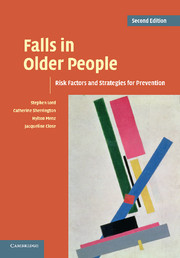18 - Falls in older people: future directions for research
Published online by Cambridge University Press: 03 May 2010
Summary
Since the pioneering work of Sheldon in the 1960s, a great deal of research has been undertaken into falls, and there is now a considerable body of knowledge about the various risk factors and the effectiveness of a range of intervention strategies. Indeed, since the first edition of this book was published in 2001, many more studies have been undertaken, with many completed in areas identified in the first edition's chapter on future directions for research. However, as in every area of scientific study, the findings of one study pose questions for another. In this final chapter, we present a brief review of a range of research issues that need to be addressed in the future.
Epidemiology and taxonomy
Common taxonomy for reporting falls and fall-related issues
Comparability of outcomes from falls prevention trials is remarkably difficult and this relates not only to the heterogeneity of the populations selected and the approaches to intervention, but also to the way in which results are reported. A vast array of statistical tests have been used and reported in the literature, including mean, median and total number of falls, number of people falling, number of recurrent fallers, time to first fall, time to first four falls, odds ratios, relative risks, hazard ratios, incident rate ratios, etc. Number needed to treat to prevent a fall or a person falling is a potentially useful comparator, but the methods of statistical analysis and data presentation used in different studies make this information impossible to extract from some published papers.
- Type
- Chapter
- Information
- Falls in Older PeopleRisk Factors and Strategies for Prevention, pp. 379 - 387Publisher: Cambridge University PressPrint publication year: 2007



